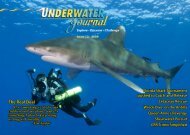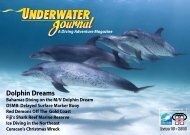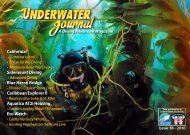- REBREATHERS - SPORT DIVERS ... - Stingray Divers
- REBREATHERS - SPORT DIVERS ... - Stingray Divers
- REBREATHERS - SPORT DIVERS ... - Stingray Divers
You also want an ePaper? Increase the reach of your titles
YUMPU automatically turns print PDFs into web optimized ePapers that Google loves.
Japan’s Most Dishonorable Act<br />
Recently I received an e-mail with a link<br />
to Oceana’s web site, http://www.oceana.<br />
org/north-america/action-center/. I watched<br />
a video that has also made the rounds<br />
on You Tube. It is a disturbing clip that<br />
documents one of the most inhuman and<br />
brutal mass slaughters imaginable. Dolphins<br />
– warm blooded, intelligent creatures not all<br />
that different from you and me – are being<br />
chassed, trapped and killed by the thousands,<br />
with not even the basic regard for life that is<br />
common in a third-world slaughter house.<br />
This year, as in years past, Japan has begun<br />
its annual dolphin hunting season. Over the<br />
next six months, the hunt is expected to kill<br />
more than 20,000 dolphins and porpoises,<br />
the majority being bottlenose dolphins,<br />
pilot whales and striped dolphins. While<br />
Japan’s position is that this brutal practice<br />
is a form of culling, they are actually killing<br />
animals that are on the threatened species<br />
list. Officials claim that the dolphins eat too<br />
many fish, and are therefore a “pest” that<br />
must be removed so as to not compete with<br />
fishermen. In actuality, the meat of these<br />
marine mammals is sold off to supermarkets<br />
and grocery stores.<br />
The full impact of these hunts on the<br />
marine mammal population is unknown due<br />
to the lack of good population estimates<br />
for the various targeted species. Scientists<br />
also don’t know the extent of the disruption<br />
the massacre causes on the complex social<br />
structure of dolphins or the affect on the<br />
ecosystem of removing so many large<br />
animals out of a small area.<br />
Moreover, the wholesale prices for dolphin<br />
meat have plummeted as fears over pollution<br />
levels have turned Japanese consumers<br />
against tinned dolphin.<br />
The Japanese dolphin hunters have<br />
admitted that they are worried the<br />
government will soon shut them down in<br />
light of international outrage over the hunt.<br />
As the publicity grows, the hunters are<br />
forced to hide their actions. They erect fake<br />
signs to divert the general public from the<br />
coves where the dolphins are ultimately<br />
trapped and have outlawed photos and<br />
videos of the killing.<br />
I understand if you just can’t bear<br />
to watch the video, part of me wishes I<br />
hadn’t. For those of you that do choose to<br />
watch it, remember the three minutes and<br />
16 seconds it takes is about half as long<br />
as some of the dolphins take to die. Please<br />
take action today.<br />
Add your name and comments in a letter<br />
addressed to the Japanese Embassy urging<br />
them to end this form of massacre. I have.<br />
For information, visit www.oceana.org.<br />
Or contact:<br />
Maureen Bonnerm<br />
E-Activism Manager, Oceana<br />
Oceana Inc.<br />
2501 M Street, NW, Suite 300<br />
Washington, D.C. 20037<br />
Phone: 202.833.3900<br />
email: info@oceana.org<br />
If you’d like to receive updates<br />
like this directly from Oceana, sign<br />
up to be a WaveMaker at: http://<br />
takeaction.oceana.org/signUp.jsp<br />
www.underwaterjournal.com June/July 2007






